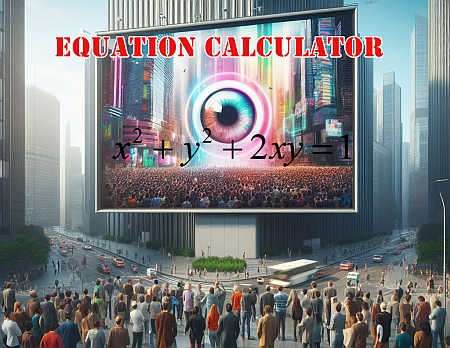Equation Calculator
Instructions: Use this equation calculator to solve an equation showing all the relevant steps. Please type in the equation you want to solve in the box below.
For example, type 'sin(x) = 0' or you can type the equation 'x^2 + x*y + y^2 = 1'. You can provide an equation with one or more variables.
More About this Equation Calculator
This calculator will allow you solve equations in general, showing all the relevant steps. First, you need to provide an equation you want to solve. For example, you may want to solve this quadratic equation \(x^2 + 3x+2 = 0\).
Or perhaps you want to solve this trigonometric equation \(\sin(x) = 0\).
These are example of equations with one variable equations. You may want to solve equations with more than one variables. For example, you may want to solve \(x^2 + x y +y^2 = 1\), which is an equation with 2 variables x and y. In this case, the calculator will try to solve for y (or solve for x, whatever is easier)
Once you provide a valid equation, all you need to do is to click on the "Solve" button, and you will be provided with all the steps of the calculations, with the final solution if any, or with the conclusion that no solutions could be found.
Can I solve all the equations?
No. Solving algebra equations that are not linear or polynomial is a complicated issue in general, and there is no universal formula or even universal approach that will solve all the equations.
And that is true for equations of one variable, and it is even more true for equations for more variables.

Though solving equations in general is hard, most equations coming from algebra problems are relatively simple, and they reduce to basic linear or quadratic equations, as well as some elementary trigonometric equations.
How to Solve an Equation?
This solve equation calculator will try to solve the equation provided by first assessing the structure of the equation, assessing if it is a kind of know type of equation, and proceed accordingly.
The steps to follow to solve an equation in general are:
- Step 1: Identify the basic structural properties the equation
- Step 2: Find how many variables does the equation have. If the equation has one variable x, you need to solve for x. If it has more than one variable, the best you can do is to solve for one variable in terms of the other variables
- Step 3: Assess whether the equation is linear or not. If it is, you can directly solve for one variable (as all variables are "isolated" from each other)
- Step 4: If it is not linear, is it a polynomial equation? if so, if the degree is above 5, there is general formula for it, only numerical methods can help
- Step 5: For polynomial equations of order 2, manipulate the expression so you arrive to using the quadratic equation formula
- Step 6: Is it a trigonometric function? Try to simplify and group, and see if things get reduce to something like \(\sin(f(x)) = K\), where it could be sine any other trigonometric function
There is not much general advise for any other type of equations that depart from these basic types. The most seemingly basic equations like
\[e^x = 4 \sin(x)\]lack of elementary ways of computing solutions
Cubic Equation Formula
Can we even solve cubic equations? Well, yes, but it is not trivial. There are general formulas for cubic equations, but they are not the simplest to recall. Like we already mentioned, anything beyond linear, quadratic or selected basic non-linear equations will be amenable to symbolic solutions.
That does not mean that we can cannot solve equations. We can indeed solve lots of them. We can fully solve linear equations, we can solve systems of linear equations, and we can fully solve any quadratic or system of quadratic equations. That is not little, but that is not even close to ALL equations.

Advantages of this equation solver with steps
- 1) Eliminate the guesswork
- 2) Quickly identity the type of equation you are trying to solve to come up with the right strategy
- 3) If you have an equation amenable to some standard methodologies, this calculator will do the necessary algebraic manipulations to get the solutions.
Ultimately, not all equations will come in the right format, and sometimes you will have to move things around a bit to put things in simpler formats, such as \(f(x) = 0\).
But as you know from this polynomial equation calculator and this polynomial roots calculator, solving even the simplest root can be really hard work.
Is an Equation Simplifier Useful?
Absolutely! Simplifying an equation before solving it can be one of the most practical thing to do. One seemingly difficult equation may be reduced to something a lot simpler after doing some basic simplification.
Use this simplification calculator to take any expression and simplify it to its simplest expression.

Example: Solve the following linear equation
Solve the following linear equation on x and y : \(\frac{1}{3} x + \frac{5}{4} y = \frac{5}{6}\)
Solution: In this case we have this linear equation in x and y, so then we need to choose one variable to solve for. Let's solve for y:
\[\frac{1}{3} x + \frac{5}{4} y = \frac{5}{6}\] \[\Rightarrow \frac{5}{4} y = \frac{5}{6} - \frac{1}{3} x\] \[\Rightarrow y = \frac{ \frac{5}{6}}{ \frac{5}{4} } - \frac{\frac{1}{3}}{ \frac{5}{4} } x\]Simplifying the coefficient leads to:
\[\Rightarrow y = \frac{ 2}{3} - \frac{4}{15 } x\]which concludes the calculation.
Example: Solutions to a polynomial equation
Find the solutions to the following equation : \(2x^2 + x y + y^2 = 1\).
Solution: We need to solve the following given polynomial equation:
\[2x^2+xy+y^2=1\]The equation has two variables, which are \(y\) and \(y\), so the objective in this case is to solve for \(y\) in terms of \(y\).
From the polynomial equation above, we find the following solution:
\[y_1=-\frac{1}{2}x-\frac{1}{2}\sqrt{-7x^2+4} \]\[y_2=-\frac{1}{2}x+\frac{1}{2}\sqrt{-7x^2+4} \]
Therefore, solving for \(y\) for the given equation leads to the solutions \(y=-\frac{1}{2}x-\frac{1}{2}\sqrt{-7x^2+4},\,\,y=-\frac{1}{2}x+\frac{1}{2}\sqrt{-7x^2+4}\).
Example: Finding solutions to trigonometric equations
How many solutions, if any, does the following trig equation have: \( \sin(x) = 0 \).
Solution: We need to solve the following given trigonometric equation:
\[\sin\left(x\right)=0\]The equation we need to solve has only one variable, which is \(x\), so the objective is to solve for it.
Solving this Trigonometric Equation
By using the properties of the inverse trigonometric function \( \arcsin(\cdot)\), as well as the properties of the trigonometric function \( \sin\left(x\right)\), we find that
\[x=\pi{}K = ... \, -\pi{}, \, \,\, 0, \,\, \, \pi{}, \, \, \, 2\pi{} \, ...\]Therefore, solving for \(x\) for the given equation leads to the solution \(x=\pi{}K\), for \(K\) arbitrary integer constant. Hence, the original equation has infinite solutions.
Other useful equation calculators
Like we have made the emphasis before, we can solve lots of equations, but not all of them. For example, we can use this system of equation solver to fully analyze simultaneous linear equations.
You can find the equation of a circle, calculate a parabola and most things involving quadratic equations, but we cannot do much more from there, at least not in general.


